Over the last three years and after over 100,000 miles of driving in my Chevy Bolt EV, I found that it could be somewhat difficult to know what to expect out of a given 50 kW CCS DC fast charger. Bolt EV owners find it extremely confusing when some “50 kW” chargers recharge half the Bolt EV's battery in 35 minutes while other “50 kW” chargers would take nearly 1 hour to add the same amount of energy.
In this story, I will explain why these discrepancies between chargers exist, and I'll share my process for identifying these chargers ahead of time. In addition, I'll describe how these different power levels can affect the time spent charging so that Chevy Bolt EV owners can set accurate expectations and plan accordingly.
Background:The biggest reason for the discrepancies between chargers
The biggest reason for the discrepancies between chargers is that there is no set, universal standard for what can be considered a 50 kW charger. Under one rating system, charging providers will determine a charger's speed by its potential peak power output, so a charger that can only output 100 A at 500 V would be considered 50 kW (100 A * 500 V = 50,000 watts). However, because most electric vehicles have less than 400 V electrical systems, real-world charging rates rarely even reach 40 kW.
In response, some charging providers have adjusted their ratings so that they account for that 400 V charging limitation for most modern electric vehicles. As a result, many newer chargers that provide 125 A at 500 V and would be listed as 62.5 kW under the old model are now listed as 50 kW. Given 400 V limits, 50 kW is probably the most accurate description for these chargers.
Recently, we've started to see even newer 50 kW chargers that actually provide 156 A, so a technical peak rate of 78 kW; however, the charging providers who install these units actually list them as 62.5 kW, or the same rating as others use for the 125 A at 500 V chargers. In the case of these 156 A chargers, the 62.5 kW rating is probably the most accurate description for these chargers because most electric vehicles will be charging at less than 400 V.
What adds to the confusion here is that many of the 100 kW or faster chargers use the same outer shell as the 50 kW chargers, and some of the older 100 A chargers can be upgraded to 125 A. Also, if a charging module is broken in one of the newer 125 A chargers, it might only dispense 100 A.
In the following sections, I'll share images and videos of various 50 kW chargers from different manufacturers and charging providers, and I’ll share the impact on the charging speeds and average charging times for the Chevrolet Bolt EV.
How Charging Rates Affect the Chevy Bolt EV
Before I dive into the chargers themselves, I want to share some of my basic heuristics about charging the Chevrolet Bolt EV at these various chargers. Hopefully, this will help set expectations for Bolt EV owners, so they aren’t surprised at the differences they encounter from charger to charger. As an abstract concept, it’s easy to see that a 100 A charger will be 33% slower than a 150 A charger, but I want to illustrate just how much of a time difference that represents for Bolt EV owners.
First, I want to say that, as a best practice, you should try to avoid charging your 2017 to 2019 Chevy Bolt EV past 65% to 70% battery on public DC fast chargers. The reason to not charge past 70% is that, at that point, the Bolt EV is charging at less than half its peak charging rate. That 70% battery still represents 160 miles of EPA rated range, which is generally plenty of energy to get to the next charger, and it’s what I refer to as the Bolt EV’s “subsequent charge range” (SCR). Essentially, after your initial charge to a full battery, the SCR is the upper limit of how far you should travel between DC fast charging stops on a trip.
Now let’s look at how the various charger speeds of 100 A, 125 A, and 150+ A affect the amount of time it would take a Chevy Bolt EV owner to charge from 10% battery to 70%. Also, not that I am not accounting for the time lost to battery conditioning during these charging sessions, which can add 5 to 10 minutes of additional charging time on the slower chargers.
Starting with the 100 A charger, I want to provide another rule of thumb. I have found that, on the Chevy Bolt EV, a 100 A charger adds about 1% battery per minute. Now, I wouldn’t set my watch to this, but I found it to be an eerily accurate prediction of how long it took me to charge to a given battery percentage. So if you find yourself using one of the 100 A chargers I have listed below, expect a 10% to 70% charging session in the Bolt EV to take about 1 hour.
The 125 A chargers are significantly faster, and it shows. Due to the Chevy Bolt EV’s high-energy density battery cells, it can only maintain its peak charging rate to about 50% battery (sometimes 55% if the battery is still cool and sometimes only 45% if the battery is excessively hot). That means that, after about 50% battery, the charging rate on the 125 A charger will drop to 105 A, which is essentially the same charging speed as the 100 A charger is capable of providing.
These 125 A chargers do have a side benefit that I don’t think is discussed enough, though, and that is that their excess power can be used to run the Bolt EV’s battery and cabin conditioning (up to a 10 kW draw) without affecting the charging rate. Essentially, on a trip in cold weather, you can heat and defog the cabin after 55% battery without ever affecting the charging rate.
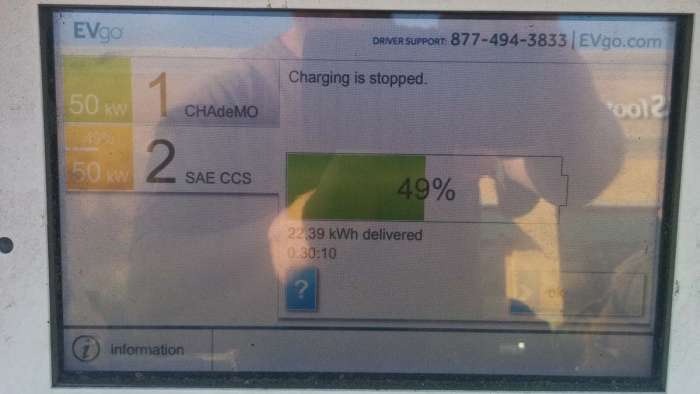
In terms of time savings, the 125 A chargers only take 33 minutes to charge from 10% to 50%, a 7 minute savings over the 100 A chargers, and they get to 70% just slightly faster than the 100 A chargers. So a typical 10% to 70% charging session on a 125 A charger will take about 50 minutes, saving almost 10 minutes over a 100 A charger.
Because the Chevy Bolt EV’s peak charging rate is 150 A, though, there’s room for even more improvement over the 125 A chargers. From 10% to 50% battery, the Bolt EV will maintain over a 50 kW, and it can take less than 27 minutes to reach its charging rate stepdown at 50%. After the stepdown in charging rate, the 150 A chargers will act the same as the 125 A chargers, only charging at slightly faster than the 100 A units but with the option of using surplus energy. A typical 10% to 70% charging session in a Chevy Bolt EV on a 150 A or faster charger will take just over 40 minutes, so you can expect to save 5 to 10 minutes compared to a 125 A charger and over 15 minutes compared to a 100 A charger.
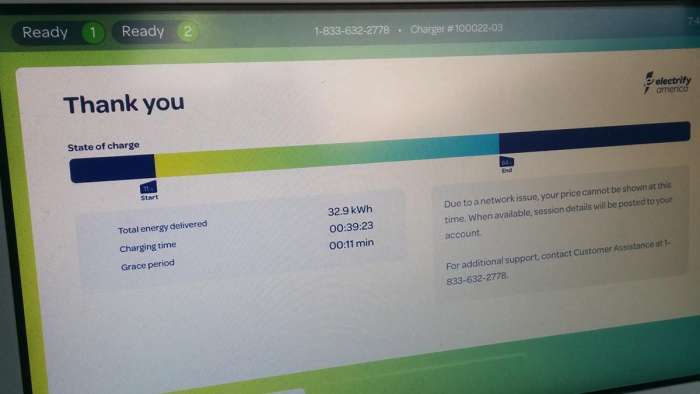
On longer trips that require multiple charging stops, it’s possible to save an hour or more simply by prioritizing 150 A chargers over 100 A and 125 A chargers. So let’s look at how to identify the various 50 kW models.
BTC Power L3R
The BTC Power L3R is a common charger electric vehicle drivers will encounter, and it’s been in use for many years. Right now, EV Connect and EVgo are the charging providers who use these units the most. The Drive the ARC program that built dozens of charging sites connecting the San Francisco Bay Area to Tahoe used these chargers, and they are also the units used by EVgo at Terrible Herbst locations throughout Nevada.
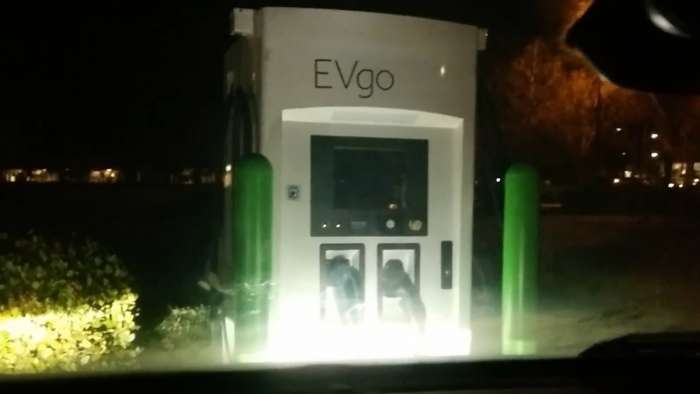
For the most part, I assume that these units are 100 A; however, these chargers are capable of providing up to 125 A. The nice thing about these BTC Power chargers is that they actually display their power output on the screen.
If you’ve never been to a location with these chargers before, you can check PlugShare for their power rating, but I recommend looking at the pictures people post of the units while they are charging. Unless I see them display more than 100 A, I assume that that is their power limit.
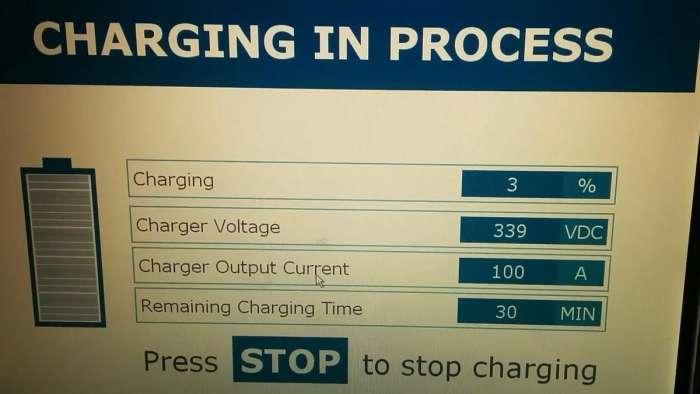
One interesting quirk about these chargers is, they sometimes display 130 A. Now, the Chevy Bolt EV could easily absorb that extra power, but unfortunately, the display isn’t accurate. I went “unicorn” hunting in one of my videos, and I was able to confirm that, despite the BTC charger’s display showing 130 A, it was only outputting 125 A.
BTC Power Slim Line
BTC Power’s Slim Line chargers are their newer 50 kW units, and so far, I’ve primarily seen them being used by EVgo for their new California Energy Commission (CEC) grant funded sites in Northern California.
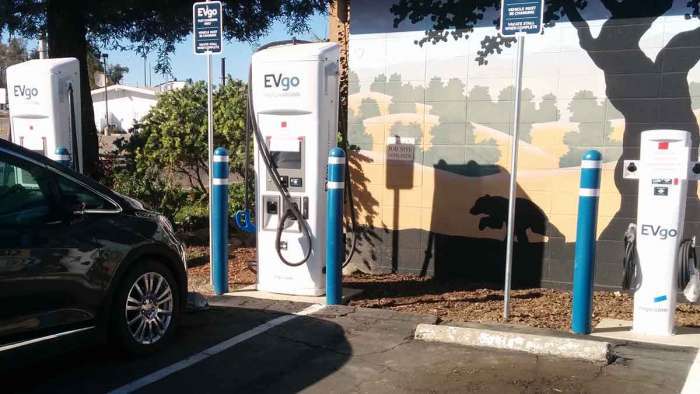
These are 125 A units, however, on a recent trip to review a site, I realized that they can also be configured as 100 A chargers. This is unfortunate because, like the BTC Power L3R chargers, you might need to check images posted on PlugShare or even the placard on the charger itself to know whether the unit is dispensing 125 A or only 100 A. Still, unlike the L3R, for the most part, I would assume that these new BTC Power Slim Line chargers are installed as 125 A unless I saw or read something indicating they weren’t.
Most of the sites where the Slim Lines are being installed are still under construction; however, I was able to test a few sites out where they’ve gone online. While I used the 100 kW charger when I reviewed EVgo’s new site in Woodland, California, the BTC Power Slim Line chargers are also in full display.
Tritium Veefil-RT (ChargePoint)
Tritium is an Australian company who manufactures the Veefil-RT chargers. The Veefil chargers have a very unique design, and they are, as far as I can find, only used by ChargePoint in the United States. These Veefil units are always 125 A chargers, and in my experience, they provide some of the most consistent charging rates of any of the 50 kW units.
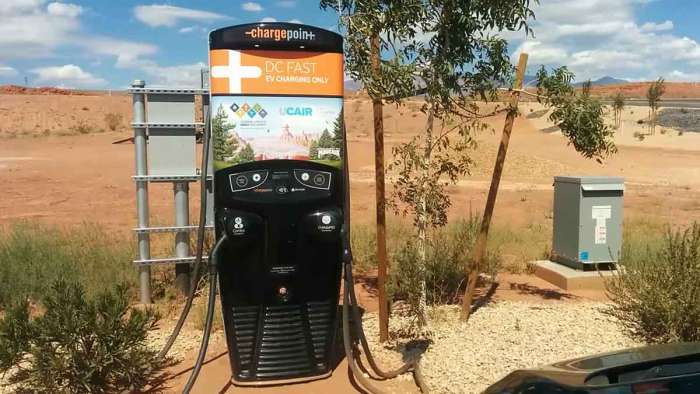
ChargePoint won a number of CEC grants for building fast charging corridors throughout the state of California, and it appears that they will primarily be using these Tritium chargers to supply those sites. These Tritium chargers are also used across the country, and ChargePoint has installed units for the Utah Clean Air Partnership at several Maverik’s gas stations along Interstate 15.
While these are good, consistent chargers for Chevy Bolt EV owners on long trips, ChargePoint is no building their own units, which can be much faster.
ChargePoint Express 250
ChargePoint has been planning to build their own chargers for some time now, and I first reviewed the ChargePoint Express (CPE) 250 unit installed at their headquarters a couple of years ago.
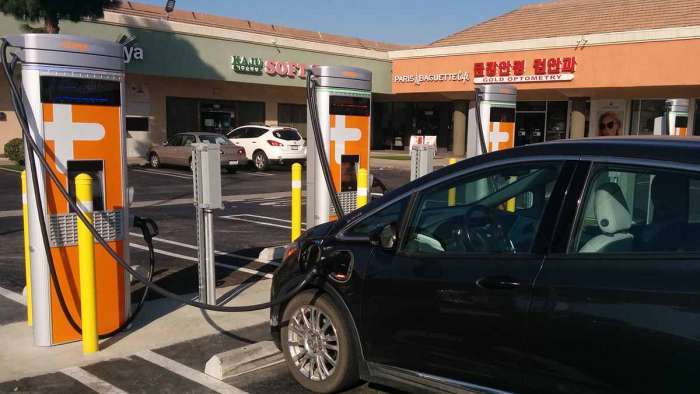
We are only now seeing these units installed, and these units can be installed in either 125 A or 156 A configurations. In fact, they can also be paired so that an individual charger can provide 125 kW when only one unit is in use (I was able to review a 7-Eleven site with the paired configuration).
In order to tell how much power these units are outputting, you have to look at the front display. So far, I’ve seen three different ratings: 50 kW, 62.5 kW, and 125 kW paired. Regardless of whether you can confirm the speed rating, these will be at least 125 A, and I would plan around that.
One exception is the Envision Solar sites I reviewed at Camp Roberts; however, the power limitations for those chargers is based on the power being generated by the overhead solar panels and the energy stored in their battery because they have limited (if any at this point) power coming from the grid.
ABB Terra 53 (EVgo)
The ABB Terra 53 is primarily used by EVgo, and it has been, in my opinion, the workhorse of their network. This was actually the first DC fast charger I ever used with my Chevy Bolt EV, so despite no longer being one of the fastest public chargers around, it’s still a personal favorite. Quite frankly, without EVgo’s sites built using these Terra 53 units along the freeway corridors of California in early 2017, my regular 500-mile trips in the Bolt EV would have been dismal at best.
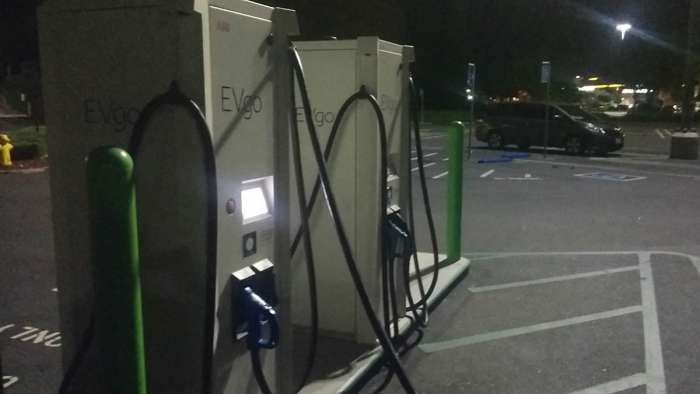
Fellow YouTube host, Alex Venz, actually attempted to replicate a trip in a Chevy Bolt EV using his Tesla Model S and a CHAdeMO adapter, but unfortunately, the EVgo sites he chose were all using the 100 A BTC Power L3R units described above. Had Alex focused on these Terra 53 sites instead, he could have easily saved 10 to 15 minutes per stop during his trip.
These units Terra 53 units are located throughout California; however, it’s unclear how many have been installed by EVgo in other states and regions. It seems that most of the reports and complaints I hear from fellow Bolt EV owners in other parts of the country aren’t related to these EVgo units but rather EVgo’s BTC Power L3R units.
Regardless, if you see one of these units, it’s almost guaranteed to be 125 A; however, I have encountered several where one of the modules had gone bad. At that point, these chargers will operate as 100 A units. That’s not great, but hey, they still function.
Conclusion
As the public charging infrastructure continues to grow, the number and type of chargers electric vehicle owners encounter will become even more diverse. For Chevrolet Bolt EV and other electric vehicle owners, the newer, faster chargers will all be roughly similar. However, when relying on the older, slower 50 kW units, it’s important to be able to differentiate between options.
The 150 A and faster DC fast chargers can save Bolt EV owners at least 10 to 15 minutes of time on typical charging stops, which can make trips faster and more enjoyable. I hope this helped to explain some of the charging options you will encounter in your travels.
See you next time as I discuss why GM needed to cancel the Chevrolet Volt and Voltec programs!
About The Author
Eric Way focuses on reporting expert opinion on GM brand electric vehicles at Torque News. Eric is also an instructional designer and technical writer with more than 15 years of writing experience. He also hosts the News Coulomb video blog, which focuses on electric vehicles, charging infrastructure, and renewable energy. Eric is an active member of the EV Advocates of Ventura County, a volunteer organization focused on increasing the widespread adoption of electric vehicles. You can follow Eric on News Coulomb Youtube, on Facebook at @NewsCoulomb as well as on Twitter at @eway1978.













Comments
We are in a charging desert
Permalink
We are in a charging desert in northern Ohio. There are almost no DC chargers, and many simple 120V ones. Bolt sales here are tiny, Leafs almost non existent, and only an occasional Ioniq or Clarity. Certainly no Korean EVs. I just drove my new Bolt from Cincy, had to stop at a Chevy dealer with DC service, charged to 75%, drove off. Temp about 40, highway speeds 70+ to keep up with traffic, heater at 65. I found that I was about 10 miles short of home on the dash readout, and stopped at a Nissan dealer. Certainly they'd have a DC charger, but only 240, so an hour later, I had my 10 miles, and drove home. 240 miles in 7 hours. Not very good for an all freeway trip.
As EV technology continues to
Permalink
As EV technology continues to improve, the goal to aspire for has not changed. EV is competing with liquid fuels....gasoline, diesel and LP gas. With gasoline and diesel fuels the fill-up process is quick, even when you factor in 18-wheelers. The driver is back on the road to his/her destination. LP fill-up is more of a logistical issue, but the actual fill-up is pretty quick. Anyone who has an LP gas tank at their home can attest to that.
So with the EV, the issue is how quickly do you get back on the road with a full battery charge and the charging centers. One literally has to plan a road trip around charging station availability......something you never have to do with liquid fuels. And if you compare a 4-7 minute fill-up with liquid fuels to how much recharge you get with that same time frame with a recharge, the need for much quicker recharging become crystal clear. When the day arrives that you can fully charge your EV batteries in under 10 minutes, have a 300 or more mile range, and charging stations are as abundant as gas pumps, then EVs will be competitive.
Great video, thanks. I am
Permalink
Great video, thanks. I am semi-seriously considering buying a Chevy Bolt before year end to get a great deal (employee pricing), and have no experience w/ either DC charging or Tesla supercharging. This was an eye opener for me. I am familiar w/ the 99 corridor, but I only drive to No Cal from So Cal like this when I am on road trip vacations...and for that we have a MBZ GLC 300 and I also have another ICE engine comfortable highway driving sedan. Still leaning towards the Bolt but if I drove long distances regularly I would definitely get a Tesla M3 !!